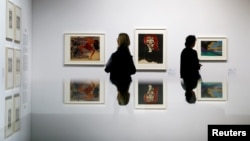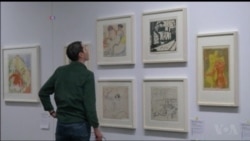A Swiss art museum on Wednesday showcased a new exhibit of artwork deemed "degenerate art'' by the Nazis, drawn from a collection of some 1,500 works found hidden in the homes of German collector Gurlitt five years ago.
The Bern Kunstmuseum exhibit features over 200 modern art pieces confiscated in a Nazi crackdown in the late 1930s against so-called "degenerate art'' — deemed inferior because they were un-German, Jewish or Communist or, in the case with impressionist and other modernist works, didn't employ traditionally realistic forms.
But the Nazis were all too happy to sell such works to help fund their war machine.
WATCH: Art Collection From Nazi-Era Dealer Goes on Display in Switzerland, Germany
The art on display in Bern, including Expressionist and Constructivist paintings by artists such as Otto Dix and Franz Marc, opens Thursday to the public.
It is part of parallel exhibits linked to the Gurlitt collection, which came to light in 2012. His father, Hildebrand, was a leading art dealer in the Third Reich.
The other exhibit opens on Friday in Bonn, Germany, with a focus on art looted and stolen by the Nazis — much from Jews. That show includes works from masters including Claude Monet and Albrecht Durer that were hidden from public view for decades.
Authorities stumbled onto Gurlitt's collection five years ago while investigating a tax case. Cornelius Gurlitt had tucked away more than 1,200 works in his Munich apartment and another 250 or so in Salzburg, Austria.
A will bequeathed the works to the Bern fine arts museum, but a German government-backed foundation has worked with it to ensure that any pieces looted from Jewish owners were returned to their heirs.
Experts initially identified more than 90 works that were likely looted by the Nazis, including pictures by Henri Toulouse-Lautrec, Henri Matisse, Edvard Munch and Rembrandt. Only four works — including a painting by Camille Pisarro — have been returned to the rightful heirs.






